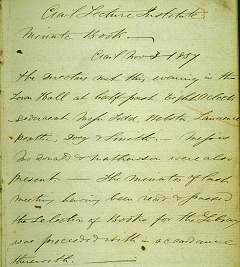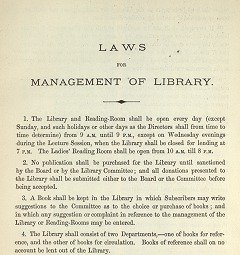Contents ![]() | Institutes of learning
| Institutes of learning ![]() | Sources
| Sources ![]()

Literary, reading and debating societies
Page 1 of 2 | Next
In the 19th century mutual improvement was a broad church. The category also includes a number of small organisations, present in many communities, which can be grouped together as literary or reading societies. Others debated topical issues, with members nominated to present cases for and against. Others took the debates a stage further by organising themselves as 'parliaments' and conducting their meetings as houses of commons in miniature. Some simply consisted of a few people who banded together to provide themselves with shared subscriptions to literary and topical magazines.
Literary societies
These organisations met regularly, usually through the winter months. Some subscribed to monthly journals, others were attached to libraries and some were even the catalyst for starting libraries. The Crail Lecture Institute was only one of many in the Burgh to provide evening lectures through out the winter months. Its aim was to promote learning to its members. To that end, a substantial library was very important. Donations of money and books were welcomed. By 1890, the institute had amassed such a number of books in its library that it required larger premises. The winter lecture series became secondary in importance to the maintenance of a good local subscription library. A public meeting called to raise awareness and recruit more members witnessed a low turn out. It is noted that a local landowner, Mr J W Duncan of Boghall, had purchased the west school building and was willing to donate it to the committee once enough subscribers had been recruited.

The programmes of literary societies usually followed a similar format. In some members would present analyses of chosen works to the assembled society, which would then be debated by the meeting. As they grew many opened premises such as the reading rooms of the Edinburgh Literary Institute. The Institute opened in South Clerk Street in 1872 and amongst its facilities were a library and separate reading rooms for men and women. There was also a newsroom. An annual subscription for a man was £1 1s (a guinea or £1.05) per year. A woman paid less. If people could not afford an annual subscription they could pay a quarterly subscription of seven shillings (35p).
Page 1 of 2 | Next
In this section:
Women's Co-operative Guilds | Scottish Women's Rural Institute | Literary and debating societies
Contents ![]() | Institutes of learning
| Institutes of learning ![]() | Sources
| Sources ![]()